Business in Oman, Muscat. Omani Economy

Omani Foreign Trade. Economy of the Sultanate of Oman. Muscat
- Introduction to the Sultanate of Oman (Middle East)
- Business in Muscat
- Economy of Oman
- Omani International Trade
- Cases of Omani Companies
- Mohammed Al-Barwani
- Access to the Omani Market
- Business Plan for Oman
International Trade and Business in Oman
The objectives of the subject “International Trade and Business in the Sultanate of Oman” are the following:
- To analyze the Omani Economy and Foreign Trade
- To identify business opportunities in the Sultanate of Oman
- To explore the Omani trade relations with the student's country
- To know the Omani Trade Agreements
- To examine the profile of Omani businesspeople and enterprises
- To develop a business plan for the Omani market

The Subject “Foreign Trade and Business in Oman” belongs to the following Online Programs taught by EENI Global Business School:
Doctorate: Islamic Business, World Trade.
Masters: International Business, Foreign Trade.
 Masters adapted to Omani Students.
Masters adapted to Omani Students.
- Credits of the subject “Doing Business in Oman”: 1

- Duration: one week

International Trade and Business in Oman
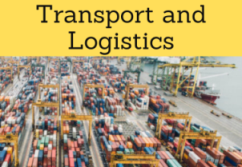
- Corridor of the Ashgabat Agreement
- North-South Corridor (India-Russia)
- Access to the:
- China-Pakistan Economic Corridor
- India-Chabahar (Iran)-Afghanistan Economic Corridor
- Kyrgyzstan-Iran Corridor
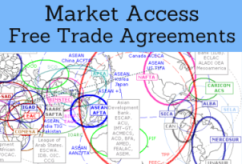
Omani Preferential Access and Trade Agreements:
- Oman and the Arab Economic Area
- Gulf Cooperation Council (GCC)
- Greater Arab Free-Trade Area (GAFTA)
- Indian-Ocean Rim Association
- Islamic Trade Preferential System
- Arab Bank for Africa (BADEA)
- U.S.-Oman Free Agreement
- Oman has Free Trade Agreements with India, China, South Korea, Singapore, Australia, the EFTA, New Zealand, Thailand, the U.S., the EU and the MERCOSUR

- WTO
- GATS
- Agreement on Sanitary Measures
- Agreement on Technical Barriers to Trade
- Agreement on Preshipment Inspection
- Agreement on Safeguards
- Trade Facilitation Agreement
- WCO
- Kyoto Convention
- IRU
- TIR Convention
- Guidelines on Safe Load Securing for Road Transport
- BIC (Containers)
- Chicago Convention (ICAO)
- International Maritime Organization
- Istanbul Convention - not a member
- Customs Convention on Containers - not a member
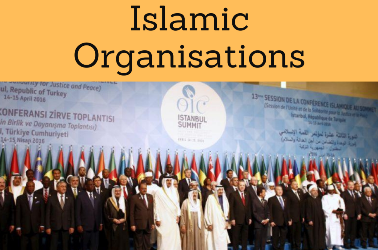
- Arab League
- Summit of South American-Arab Countries
- Asia-Middle East Dialogue
- Islamic Development Bank
- ESCWA
- OIC
- Committee for Economic Cooperation
- Islamic Chamber of Commerce
- Islamic Centre for Development of Trade
- Statistical Economic Centre for Islamic Countries
- Arab Gulf Programme
- Arab Trade Financing Programme
- Arab Development Funds
- Afro-Arab Cooperation
- BADEA

- Asia Cooperation Dialogue
- UN
- UNCTAD
- ITC
- WIPO
- WB
- WTO
- IMF
- The capital of the Sultanate of Oman is Muscat (1.2 million people)
- Oman is a Monarchy
- Thanks to its strategic location at the Persian Gulf entrance, Oman is considered as a country of significant geostrategic value
- Oman shares borders with Yemen, Saudi Arabia, and the Emirates
- Abolition of Slavery in Oman: 1970
- Official language of Oman: Arabic
- Area of Oman: 309,500 km²
- Omani Population: 4.3 million people
Religion in Oman.
- Islam Sunni is the main religion in Oman
- Maliki is the main school of Islamic Jurisprudence
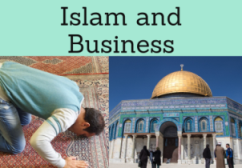
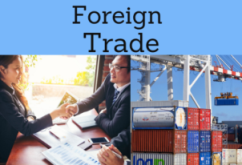
Economy of Oman
- The main natural resources of Oman are petroleum and natural gas
- The proven petroleum reserve (4 billion barrels) are not crucial, so the Omani Government wants to make Oman one of the leading natural gas Exporter
- The main products manufactured in Oman are textiles, cement, furniture, fertilizers, and fiberglass products
- The main suppliers are the United Arab Emirates (UAE), Japan, and the UK
- The main Omani export markets are China, Japan, and South Korea
- The currency of Oman: Rial (OMR)
The largest Omani companies are located In Muscat:
- Suhail Bahwan, retail partner for firms such as Toshiba, Subaru, Seiko, Hewlett-Packard, General Motors, RAK Ceramics
- Saud Bahwan Group: Toyota regional distributor, Daihatsu and Hertz Rent-a -Car
- Zubair Automotive, Mitsubishi distributor, Chrysler, or Dodge
The Mina Sultan Qaboos is the largest commercial port. The port is also a vital Foreign Trade centre between the Persian Gulf, Indian subcontinent, and Far East with an annual volume of 1.6 million tones.
The creation of the Jebel Ali Free Zone in Dubai - the United Arab Emirates, has made increasingly diminish its importance in the region.
Hasan Juma Backer Trading & Contracting has invested 700 million dollars in the dry port project of the Port of Abidjan.
Oman is a member of the UN, IMF, WTO, Group WB, GCC, Greater Arab Free-Trade Area...
US-Oman Free Trade Agreement:
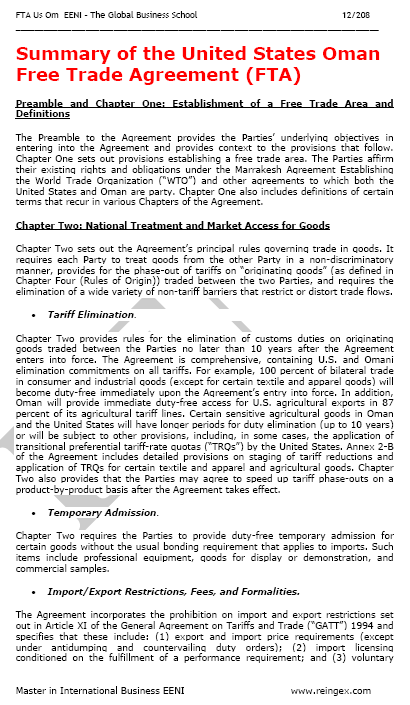
(c) EENI Global Business School (1995-2024)
We do not use cookies
Top of this page




 or
or 
